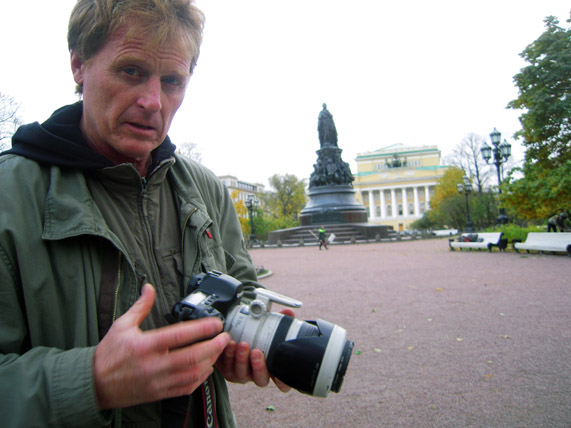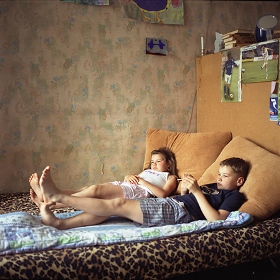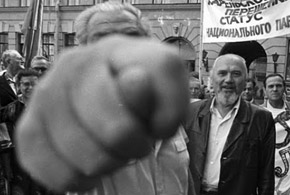The end of photojournalism in Russia

By Dalia Lourenço
Photojournalist Dimitri Koshcheev stops to take pictures of people
raking leaves in a park on Nevsky Prospekt, the main avenue in St.
Petersburg, Russia.
No one cares.
When he carried his camera in the same city during communist times,
people would often approach him, suspecting he was a spy.
Russian photographers have lived through various stages of creativity
and censorship in the last century. These days state censorship
is no longer an issue, yet photojournalism fails to thrive as a news
medium.
The Soviet Union
Photographic propaganda was a vital ingredient to communist
society. The Leningrad Underground Photography, published by the
State Russian Museum, explains that by publishing photos of symbolic
Soviet figures, ceremonies and achievements, its government aimed to
idealize the communist lifestyle and maintain public enthusiasm for the
regime. Consequently, any images that were not ideologically
charged were shunned, resulting in a one-sided portrayal of society.
Official Soviet photographs included military parades, smiling
workers in fields and factories and children in the “Young Pioneer
Association” donning matching scarves.
According to Nailya Alexander, founder of the Nailya Alexander
Gallery specializing in Soviet and contemporary photography,
photojournalism took on a creative nature immediately after the
Bolshevik revolution. Photographers began experimenting with the
use of close-ups and tilted angles in order to create the image of the
ideal Soviet citizen.
The idealistic nature of Soviet photography was forced to evolve
during the Second World War. While photographers had many
restrictions, including being prohibited from taking pictures of dead
Soviet soldiers, the destruction and suffering inherent in war could not
be masked. While photos continued to be taken from a
pro-Soviet angle, the war created a leap in the country’s photographic
history.
By the 1980s, the restrictions had loosened significantly although
they were not eliminated. Photographer Sergey Grachev remembers
editors stamping their approval on the back of prints submitted for
publication. Grachev had to avoid photographing anything that could be
interpreted as poor or outdated. He says he once submitted a seemingly harmless photo to a university newspaper portraying a
student writing in a notebook. The editor warned Grachev to be
careful with future photos because in the background he had captured an
old heater that had been out of use for 50 years.
Russian photographs in the
1990s capture the climate of change and turmoil. Here people unite in
support of keeping the name “Leningrad” for their city. (Photo courtesy:
Alexander Belenky)
As a result of these restrictions, an underground photography culture
developed. Photo enthusiasts formed unofficial clubs where they
displayed their work to friends behind closed doors.
Koshcheev learned to take photos as a member of “Club Zerkalo”. He
explains the club’s name means “mirror” and its members photographed
all aspects of life. While official photography portrayed only the
“white,” unofficial photos exhibited the “black and the grey” of
society, such as people drinking or idling in the street.
Political turmoil and photographic freedom in the 1990s
“In the 90s Russia was an interesting country for taking photos,”
says the editor of the St. Petersburg Times, Alexander Belenky, “Nobody
knew the future of Russia. Who will win? Communist or
democratic?”
Indeed, after the collapse of the Soviet Union in 1991, the Russian
Federation’s newness and instability made for interesting photos.
New businesses, financial upheavals and demonstrations and protests of
all kinds ensured there was plenty to photograph.
Furthermore, as the political environment changed, so did the public
mindset and people’s reaction to cameras. In Soviet times, people
were suspicious and mistrustful. Photographers ran the risk of
being mistaken for western spies trying to document the misery of
communist society. Someone taking a picture of garbage or a
dilapidated building could expect a passerby to approach and ask
questions. With the collapse of the Soviet Union, photographers became
free to take pictures of everything.
It also became easy for photojournalists to get into institutions
like prisons and hospitals to take good pictures.
Finally, after the downfall of communism many photojournalists felt
inspired to be working for independent press rather than the government.
“Journalists felt freedom coming,” says Grachev, “and that we will
build our newspaper.”
Today
These days, working for an independent newspaper does not necessarily
spell freedom.
After working at the independent Argumenty i fakty newspaper for a
decade, Koshcheev recently resigned because a new boss began dictating
what he must photograph. He now works for the government newspaper
Russkaya Gazeta, where he gets along better with management.
Freelance magazine photographer Max Sher says Russians are going back
to old authoritarian habits. “We have a very bad tradition of
abuse of power. It’s always been this way.” He says there is
a vicious cycle of the powerless hating authority but becoming equally
corrupt if given an office.
Photojournalists, including those on good terms with their managers,
complain about a lack of access to their subjects. Paranoid
authorities enforce excessive security. In many cases, a press
pass is worthless, whereas in Soviet times it produced respect.
In some cases, photojournalists encounter more obstacles than the
public. In Moscow’s Red Square, for example, it is illegal to take
pictures with a large camera, while smaller cameras and camera phones
are permitted.
In order to take pictures of institutions photojournalists face long
bureaucratic chains. Whether attempting to gain access to
the inside of a building or simply trying to take a photo of its façade,
bureaucrats frequently tell journalists to return another day or month
but without specifying a date. With regulations constantly changing,
photojournalists never know what they must do to get a photo.

The stories illustrated by Max Sher’s photos
could not be told during Soviet times. This photograph is from his
series Kommunalka, revealing the pains of communal housing in St.
Petersburg. (Photo courtesy: Max Sher)
At the same time, there are ways to sidestep even the most stringent
guidelines. Sher says simply showing respect and friendliness can
be enough to gain access, especially in rural areas where inhabitants
enjoy the attention. Bribery is another option.
While photojournalists must face certain obstacles to take photos,
they rarely find themselves in physical danger. The exceptions are
war photojournalists, whose safety is of course at risk by their mere
presence in war torn areas. In contrast with Soviet times, average
photojournalists no longer worry about persecution for their
images. Elena Redkozubova, who worked as a photojournalist for the
Komsomolskaya Pravda newspaper and Grazia magazine says when a story
reports inconvenient facts, businessmen and politicians would rather put
pressure on a journalist than a photographer. As Sher explains,
without words the photos have no context. Several journalists have
been murdered in recent years but photojournalists do not feel
threatened.
“What is good about this current state of Russia is that you can be
creative and do what you want without any interference from the State,”
Sher says.
The artistic photographic tradition developed during Soviet times has
lasted into the present. The U.S. Library of Congress,
which holds a collection of Russian prints from the 1990s and beyond,
explains on its website that these images tend to display more emotion
than the photography of the West, which is usually more documental.
Editors are increasingly using photographs for mere page layout
rather than journalism. Consequently, their photos do not always
relate directly to the story. According to Belenky, what is
usually important about a photo is the space it fills on the page, not
its journalistic content.
As in most of the world, in Russia it is becoming increasingly
difficult to make a living from photojournalism. Some publications
pay as little as 50 roubles, or less than two Canadian dollars, per
photo. And online publications pay even less for photos than do
print.
With the end of the communist regime and the invention of television,
photography no longer plays as important a role in the Russian
Federation as it did in the Soviet Union. It is photojournalists’
passion for photography and people that keeps them in the business.
“You know these days, you have to stop dreaming about being a
photojournalist,” says Sher. “This profession is kind of dead or
was always dead. Classical photojournalism as we know it… it’s over.
It’s the same as becoming a blacksmith. You can become a
blacksmith but just for fun you know, for art.”
He adds, “It’s no longer a news medium, that’s the point.”
